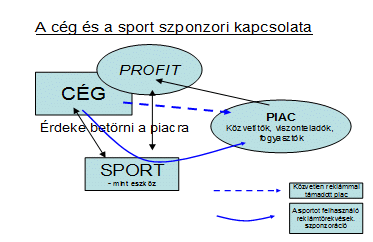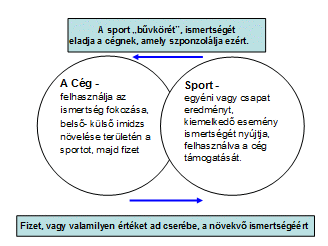Sports as advertisement. Sponsorship.
The whole world is a market. ,
Every man and woman is a customer and buyer in it.
(After Shakespeare)
Having rephrased Shalespeare’s famous sentence it can be concluded that every element of our life is determined by the laws of market economy and marketing approach.
The task of sports marketing is to discover and interpret consumer needs and create products or services which meet those needs. The possibilities of sports for innovation have greatly been improved by developments in technology (the production of state-of-the-art sports equipment) and communication. An example of the above is surfing not only on water, but on snow and in the air. Sports events are broadcast all over the world and, consequently, they are marketable. Due to its specificities sports is of much interest for the majority of people. This interest intrigued other market players, too, and they started advertising campaigns within the framework of sports events.
Companies – schools and non-profit organizations (sports clubs) build their relationships ont he basis of the following:
These days customers and consumers make their decisions not only ont he basis of prices and quality, but they also take into consideration the business views of the company and to what extent the meet society’s expectations. These specific areas include the support of issues and organizations of utmost importance, for example the protection of the environment, healthy eating, arts, non-profit organizations, foundations etc. The businesss polcies of certain companies migh include sports and recreation as well. An increasing number of companies have recognized that fringe benefits (health, culture, sports and recreation) represent an important tool in reproducing their work force. The presence and the quality of the above services might play a role in keeping local work force.
Sports and advertisements have a double function. Ont he one hand sportspeople and sports facilities represent media, they carry and trasfer messages, and link the transmitter and the reciever. On the other hand the sports organization, agency the sports facility as well as the organizers of sports eventa are engaged in marketing activities. (Hoffmann, 2000)
The efficiencí of marketing and sponsorhip mainly depends on the interest of the supporters. The spectators as well as the media are mobilized by large-scale sports events with outstanding scores. The Boston or the Budapest marathons can be mentioned as examples because one can find the world’s best marathon runners competing in these events, and they attract masses of lifestyle runners, and their race is observed by thousands of spectators int he streets and hundreds of thousands and millions of people worldwide on TV.
By the IAAF1: Sponsorship is a form of investment made in money or other items..
In 1999 in Germany 70% of sports sponsorship was paid in the form of money, the rest was in other form. In Hungary this value is typically 50-50 %, buti n certain cases there is a 30- 70% swing int he direction of other goods. If sports-event related receptions are considered, this proportion might be 0-100% .
„Sponsorhip is undertaking a warranty for a special event.”
Sponsorhip might come into nbeing int he form of business relations between two parties. It is the sports organization or event or the business company that plays the role of the initiator. In the first case the sports organization or events organizer will turn to the company , while int he second case it is the business company that asks the sports organizers for advertising possibilites. Examples include running events like WESTEL, T- mobile or Samsung- runs.

Figure 2. The relationship between company and sports. Source: Kiss,1999.
Company, profit, market. It is the company’s interest to break into the market. The market consist of consumers, resellers, and mediators. Sport is a tool. It might represent direct marketing or might be the target off sponsorship.
The sportsman/team wears the emblems and the colours of the school, settlement, country, of a whole community. Sports achievements, as well as the size of the crowd of supporters can be attractive for the media, thus its fame will grow further. It is a kind of ’magic circle’. This fame is attractive for the companies, too, because they also want to be similarly popular with their consumers. It is one of the basic tasks of sports leaders to convince the companies related to them to advertise their products through sports. This kind of sponsorsip is beneficial for the company because they support community interests and good for the sports as well.
The balance of sports sponsorship

Figure 3. Kiss – Szabó (2003) The basics of sports leadership, organization and sports marketing p. 68
Sports is selling its ’magic circle’ of popularity to the company and it will sponsor sports in return. The company uses sports to increase its popularity and enhance its image and pays for it.
Sports provides high scores of individual sportspeople or sportsteams using the company’s support.
The company pays or offers some other value for its increasing popularity.
How to organize relations and sponsors?
It can be concluded from the above that gaining support from sponsors is a major source of income for sports events. Involvement in sponsorhip should be planned in advance. The tasks are as follows:
- Preapration of a sponsorship offer.
- Compilation of a list of potential sponsors
- Building a team responsible for PR and sponsorship
- Signing sponsorship contracts
- Performance of contract (media, documents, press conference etc. )
- Performing service to sponsors
- Writing a report and the preparation of documentation for each sponsor. Sustainability.
What does a sponsor expect for his/her money?
- Publicity, primarily in the leading media, which can be the local media
- Enhancement of its image
- Expanding circle of its buyers
- Improvement of reputation and goodwill
- Demonstration of its goodwill
- Other needs (e.g. use of logo or name)
One contract cannot meet all the requirements but contractual tasks need to be performed.
It is very important to plan an offer for the sponsor. An example might include the following:
- Brief introducvtion of the given product, event or sports event.
- Historical overview from the past to the present
- Plan for implemetation
- Plan for the media
- Possibilites to advertise sponsors and the costs involved
- A list of general services offered to the sponsors (telephone, fax, cafeteria, meeting room etc. )
- Exclusive sponsors and extra services (main patron, suppliers, exclusivity etc. )
- Possibilites for sponsorship, cash, services, products etc. )
- Selection from press reviews, references
Considering the tactics it is th ebest to have an appointment with the chosen sponsor or its representative and give him/her our written offer. It is also advisable to attach a cover letter to it with our signature. These documents should meet the aesthetic requirements as well as the standards of formal writing/letters. Also, we should pay attention to the rivals, too. It is ethical to inform each other correctly about our plans. The contract needs to be brief and clear; it should be built on precise data and correct deadlines and should name the responsible persons. It is also important to decide at the very beginning what is public and what is not-for-the-public information. The sponsor must feel that he/she is taken care of and what he/she gets is proportionate with the monedy he/she pays. It is important to keep in mind that it is the organizer who has to offer more if the sponsor bestows the money before the sports event, or makes part of it available for the organizers. It is important, too, that the evalaution, monitoring and aftercare should be done formally and correctly.
[1] International Association of Athletics Federations (IAAF)): the international management body of athletics.